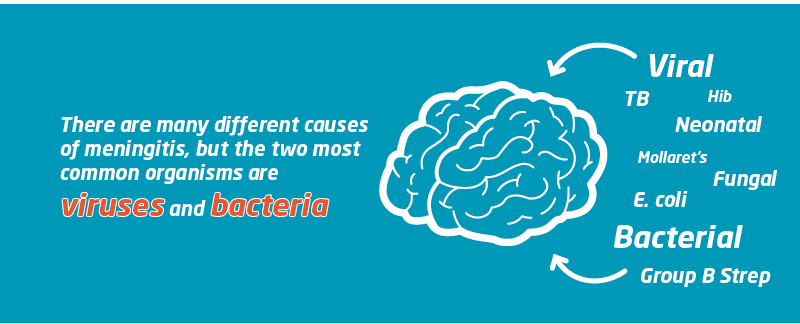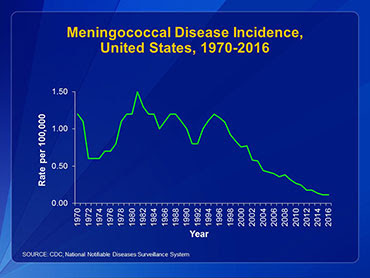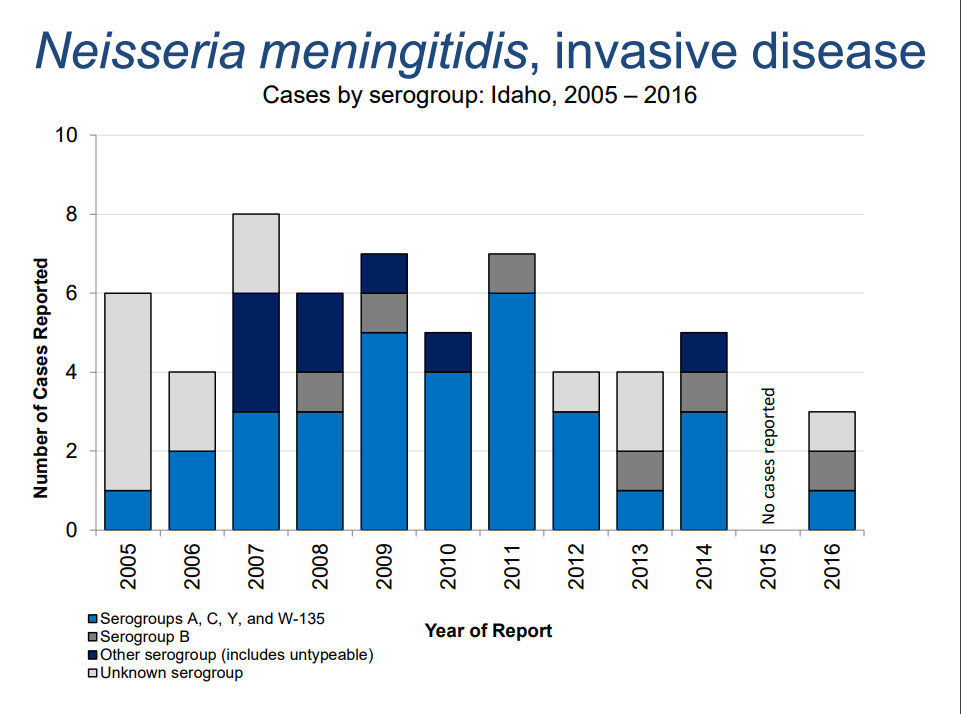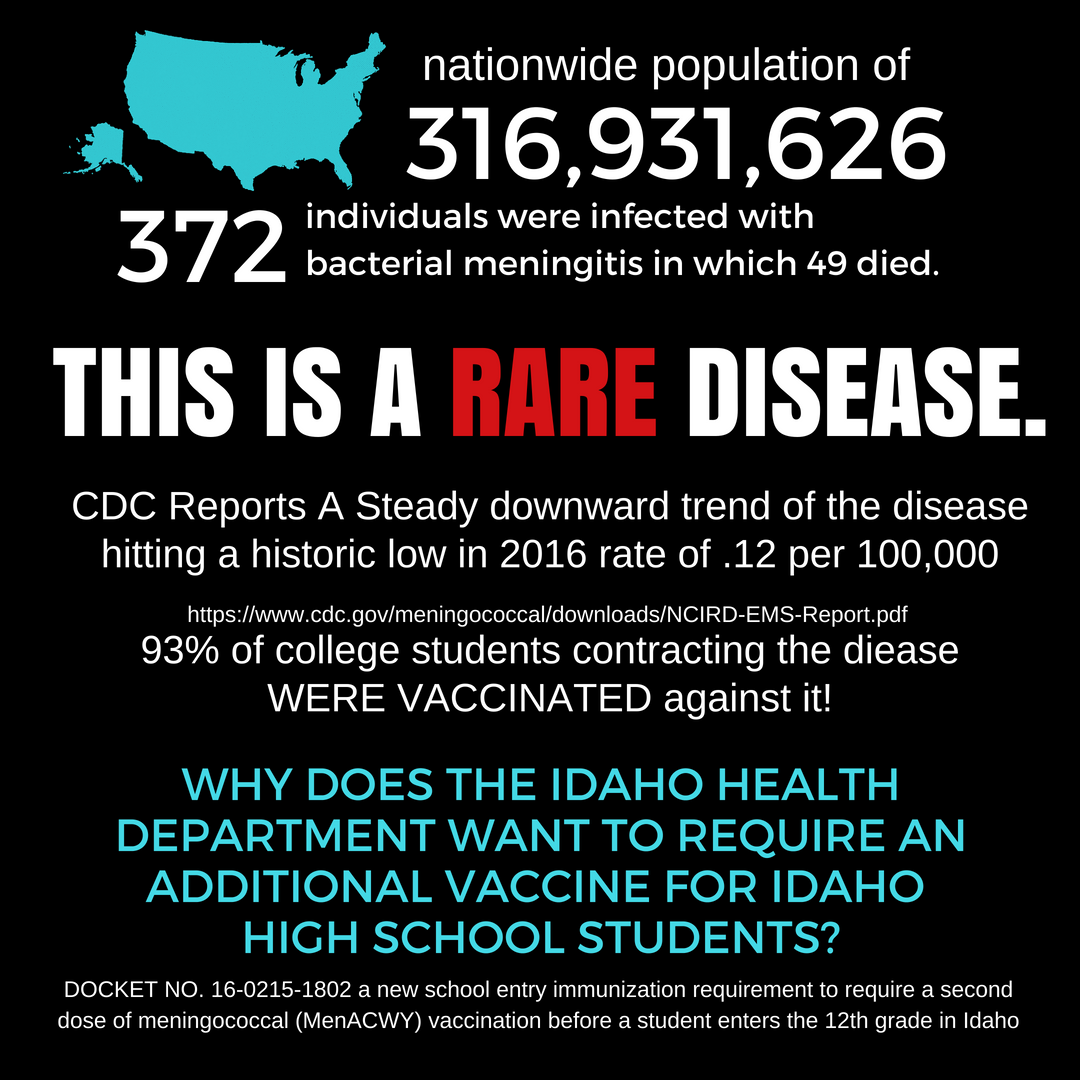Meningitis Facts

IDHW is set to add another vaccine to the required high school schedule. Meningitis. According to the IDHW website, meningitis refers to an inflammation of the tissues covering the brain and spinal cord. This inflammation can be caused by viruses and fungi, as well as bacteria. Viral meningitis is the most common type: it has no specific treatment but is usually not as serious as meningitis caused by bacteria. CDC mortality statistics reveal that there is a literal one in a million chance you will die from bacterial meningitis in the US. There are around 300 cases in the United States annually. CDC reflects a downward trend in the disease prior to vaccine recommendations. [1]Idaho has an average of 3 cases a year the past twelve years. Still, Idaho Health Department intends on requiring an additional dose of the MenACWY meningitis vaccine for a majority of the state’s high schoolers.

The CDC says there are two types of meningococcal vaccines available in the United States:
- (MenACWY) Meningococcal conjugate vaccines targeting A, C, Y, and W-135 (Menactra® and Menveo®)
- (MenB) Serogroup B meningococcal vaccines (Bexsero® and Trumenba®)
Serogroup B is now responsible for 60% of U.S. cases of meningococcal disease
During public testimony July 2018, IDHW gave the reasoning for this new requirement of an additional dose of the MenACWY vaccine. The CDC added it to the recommended schedule. And, it’s to protect the students who decide to go to college. Yes, you might have you heard of the meningitis outbreaks on college campuses.
The flaw with this reasoning? The MenACWY vaccine is NOT the bacterial strain most commonly found on college campuses outbreaks.[2] According to the National Meningitis Association, the serogroup B bacteria accounts for more than one-third of the cases of the disease in the country and is only covered by the MenB vaccine.
It’s puzzling if the reason for adding an additional requirement is for the protection of future college students, then why not mandate the alternate MenB vaccine?
Meningitis is a very rare disease.
In the United States last year there were 372 cases. 31 of cases aged 16 -23 of the strains covered by the MenACWY vaccine.
- The MenACWY vaccine IDHW intends on requiring for high school covers 2/3rd of the bacterial strains of meningitis but NOT the bacteria of most serious concern for young adults.
- Serogroup B accounts for one-third of U.S. cases, and is the most common cause of disease in adolescents. The required vaccine doesn’t cover Serogroup B.
- MenACWY has proven less than 58% effective two to five years after vaccination. In a college setting 91% of students who got meningitis were vaccinated with the MenACWY vaccine.
Is meningitis serious?
Yes. But, with only 4 strains of bacterial meningitis and 0 strains of viral meningitis are in the recommended vaccine, it’s a guessing game, similar to the flu shot, on which strain you’d even be exposed to. The vaccine, in creating an artificial immune response, actually leaves you more vulnerable to the more virulent strains of meningitis, not covered in the vaccine.
Meningitis isn’t spread by standing next to a person. The bacteria doesn’t live very long outside the body. Transmission is spread exchange of saliva through kissing, sharing drinks or sharing toothbrushes.
Neisseria meningitidis, the meningococcal bacteria, is passed by coughing or contact with saliva and is normally present in the respiratory tracts of healthy people without causing disease [3, 4, 5]. In fact, probably no one escapes infection. Symptomatic disease is quite rare for N. meningitidis. As such, 100% of the population, vaccinated or not, are asymptomatic carriers at some point in their lives. In fact, at any time, 5-35% of the population is silently carrying the bacteria, though the numbers often rise to nearly 100% in close quarters, such as military barracks and college campuses [4].
Is the meningococcal vaccine safe?
- The meningococcal vaccine has been found to be about 58 percent effective within two to five years after adolescents have gotten the shot and, in 2011, CDC recommended that all 16-year-olds get a booster dose of meningococcal vaccine;
- The manufacturer product inserts for meningococcal vaccine list adverse events reported during clinical trials or post-licensure, including irritability, abnormal crying, fever, drowsiness, fatigue, injection site pain and swelling, sudden loss of consciousness (syncope), diarrhea, headache, joint pain, Guillain Barre Syndrome (paralysis), brain inflammation, convulsions, and facial palsy.
- Using the MedAlerts search engine, as of August 5, 2018, there were 24,344 cases of reported adverse reactions reported to the the federal Vaccine Adverse Events Reporting System (VAERS), for the MenACWY vaccines which includes only a small fraction of the health problems that occur after vaccination in the U.S., The vaccine caused 2477 serious health problems, hospitalizations and injuries following meningococcal shots, including 146 deaths.
Is the meningococcal vaccine effective?
GOT THE SHOT – STILL GOT THE DISEASE!
Not according to the CDC’s enhanced report on meningitis! Read the report: https://www.cdc.gov/meningococcal/downloads/NCIRD-EMS-Report.pdf
92% of college students living onsite who contracted the meningitis were vaccinated against the disease with the MenACWY vaccine Idaho Health Department is requiring for high school students.
Is the mandate of an additional vaccine necessary?
The disease is on a downward trend, even without the ‘herd immunity rate’ of 95%.
Figure 1 shows incidence rates (per 100,000 persons) of meningococcal disease in the United States by year from 1970 to 2016. The incidence rate began declining in 1995; however, it has reached an historic low of 0.12 in 2016. View data for this chart.

Idaho infectious disease reports shows the following for Neisseria meningitidis, often referred to as meningococcus. Which causes cause meningitis and other forms of meningococcal disease such as meningococcemia, a life-threatening sepsis.
Idaho’s rate of infection shows actual cases reported for the ACYW serogroups average 3 cases a year. Nowhere is it reported that meningitis was transmitted in a school setting.
Taking into account the vaccine effectiveness rate of 58% that’s recommending vaccines for a majority of high school students to prevent about 1 case of meningitis that does not even show transmitted in a school setting.

There is no discussion here about the financial impact of requiring an ineffective vaccine for our high school students. Those who testified in favor of the new vaccine requirement would all financially benefit from the increased vaccine load. The individuals who spoke against the vaccine recommendations were parents of students who would be directly impacted by any adverse reaction their child would suffer.

How can you, as a parent, best protect your child from meningococcal infection?
Answer: Improve your child’s immune system by providing a healthy diet of whole foods that are rich in nutrients. Give supplements that are high in antioxidants, balanced B-vitamins, minerals and essential fatty acids. Give extra vitamin D3 during cold and flu season. Heal the gut if your child has gastrointestinal problems. Stress the importance of getting enough sleep and fresh air. Help your child learn to relax. And, just say NO to vaccines that damage your child’s innate immune system.
Read about this vaccines function, efficacy and reactions here:
https://schaabling.wordpress.com/2016/01/01/meningococcal-vaccine-meningitis/
[2] https://www.nmaus.org/disease-prevention-information/serogroup-b-meningococcal-disease/outbreaks/
[4] http://femsre.oxfordjournals.org/content/31/1/52.long?view=long&pmid=17233635
[5] http://www.whale.to/vaccines/meningitis5.html
Proposed Rule:
https://adminrules.idaho.gov/bulletin/2018/07.pdf#page=91
DOCKET NO. 16-0215-1802 (pg 91) The Health Department wants to “require a second dose of meningococcal (MenACWY) vaccination before a student enters the 12th grade in Idaho, starting with school year 2020-2021. If a student received their first dose of meningococcal (MenACWY) vaccine at 16 years of age or older, they will not be required to receive the second dose before entry into the 12th grade.”
https://www.millioninsights.com/industry-reports/meningococcal-vaccines-market
Idaho Infectious Disease Reporting:
http://healthandwelfare.idaho.gov/Health/Epidemiology/IdahoDiseaseSummary/tabid/202/Default.aspx
Disease Trends in Idaho:
http://healthandwelfare.idaho.gov/Portals/0/Health/Epi/Disease%20Summaries/ID%20DZ%20Trends_2016_FINALv2.pdf
Rates of Vaccination: https://www.cdc.gov/vaccines/imz-managers/coverage/teenvaxview/data-reports/menacwy/trend/index.html








